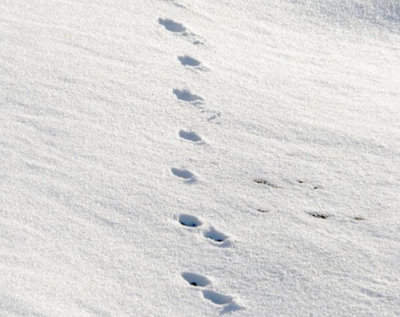Feet in the snow bring ears to the music
Now some folks like the summertime when they can walk about
Strolling through the meadow green, it’s pleasant there is no doubt
But give me the wintertime when the snow is on the ground
For I found her when the snow was on the ground . . .
“Footprints in the Snow,” Bill Monroe
So, a pair of deer have found our backyard to be friendly ground. My wife believes that for one of them music plays a factor in its wandering. She noticed tracks last week, thanks to the freshly fallen snow. One set traveled north out of the woods, circled a couple of trees, and headed back into the woods at the south end of the yard. The other set came close to our house as though something inside the building was intriguing.

Beth decided to check out the tracks and noticed the creatures behind both sets. They were both does, one of which saw our yard simply as a safe path from one end of the surrounding woods to the other. The second doe seemed intrigued by something inside our living room, the space where my CD player was spewing out Counting Crows’ “Long December,” probably wondering if this year really would be better than the last. Well, that’s a good question, given the nature of all that has happened since 2021.
As we watched the close deer attend to what it was hearing, its ears bending downward and upward in time with the music, we weren’t able to know what the music meant to it.
I probably should have pulled my copy of This is your Brain on Music from the bookshelf to be reminded that, at least in humans, real physical changes occur in the brain in response to different kinds of music. Do these same realities occur in animals (in this case, deer) as they hear chords, strings, brass tones, drums, vocals?
It is answering questions such as this that raise others, regarding differences between humans and animals.
So, back to the deer in the yard. Both animal and place contribute to what makes Vermont special. While each section of our globe seems to carry a connection between land and the living, I have grown fond of Northern New England as a region into which I have myself mutated—coming here after growing up on the Midwestern plains, where much of the green one saw had been planted by local owners to shelter their farm buildings. One had to get far north to the Canadian border before forests became prominent—forests, lakes and other boundary waters.
I invite the animals to continue to use our backyard as an open passage from wherever they are coming to wherever they are going, be they wild turkeys, deer, bear or the birds chowing down at our seed feeder. That gives our territory a good range in animal sizes—titmice to black bears, with human beings caught in the middle.
I want to suggest that, while physically we are not overly special, mentally we rule the roost. Our brains focused on the land and its qualities are like our brains on music. They change physically as we learn to live and adapt.
As an educator, I’m interested how and where this learning occurs. I was taught that schooling is one thing; learning is likely to be another. Schools were established to give young people a place to go. Learning is something that happens in many settings. I had a professor who said that learning comes via a “constellation,” of which schooling is just a part.
Given the questions around schools and the coronavirus, that constellation may have to be studied in order to discover through which methods of learning will work. The channels are not just schools. They are families, jobs, recreational activities—most elements of our lives.

